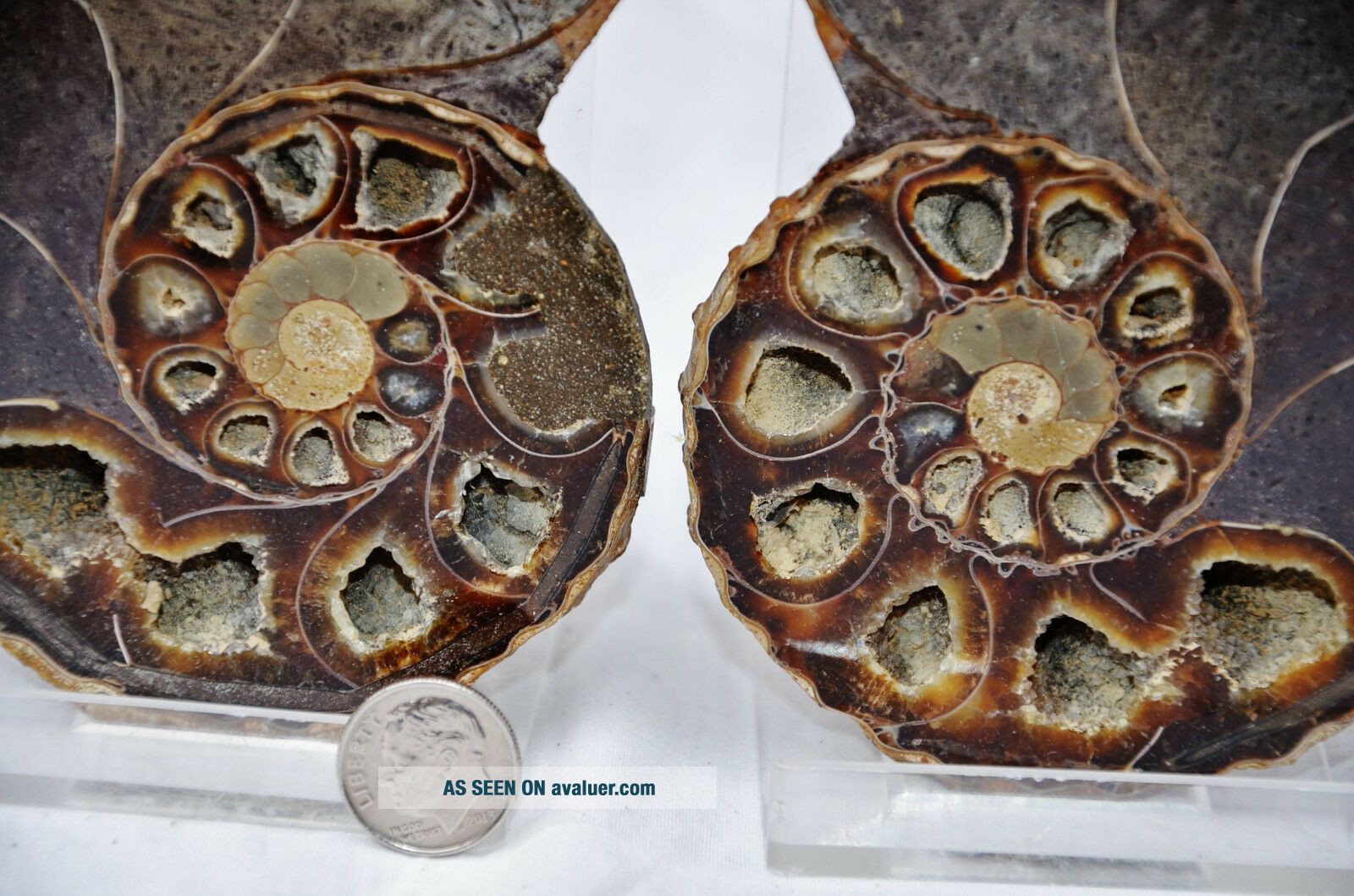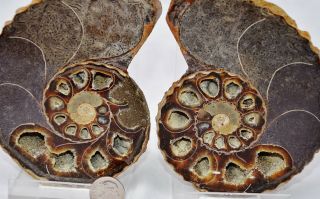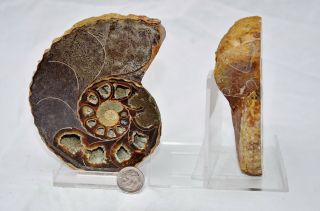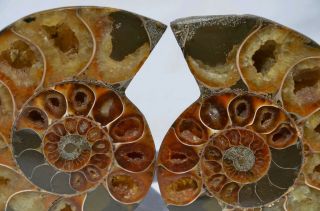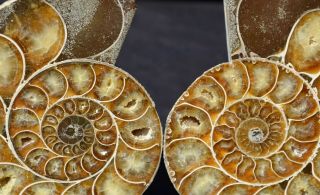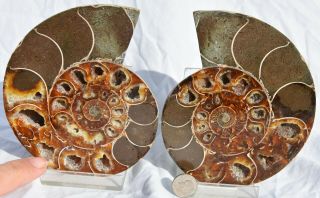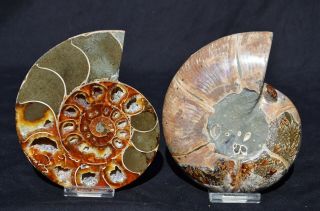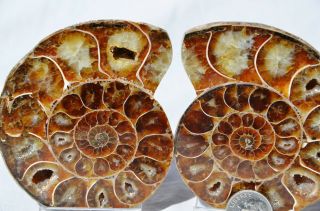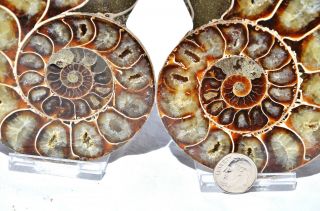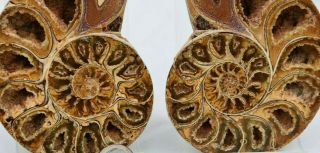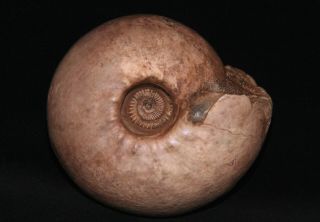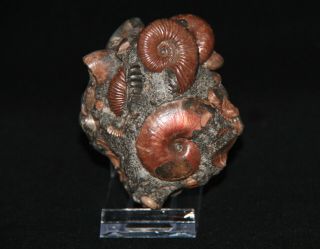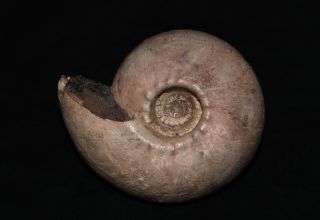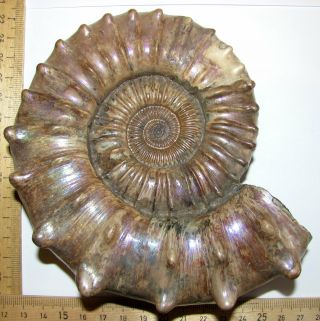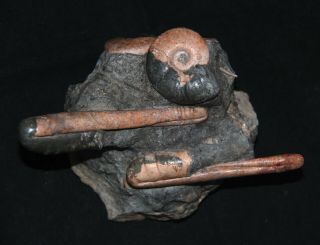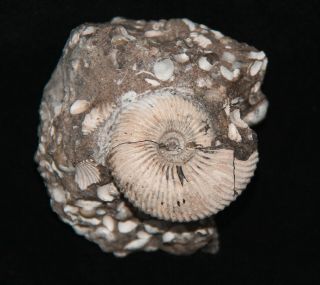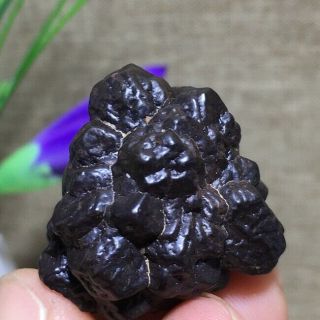Cut Split Pair RARE ANAPUZOSIA Ammonite D - Shaped LARGE 4. 5 " Fossil 114mm N1266xx
Item History & Price
| Reference Number: Avaluer:31689114 | Country/Region of Manufacture: Madagascar |
Weight (lbs): 1.5#
Weight (gm): 650 grams
Size (inches): 4.5" x 3.7"
Size (mm): 114 mm x 92 mm
Mine location: Madagascar
Item Number: n1266 3 26
Retail value: $400----------------------------------------------------------Facts about ammonites -Closest living relative - Octopus, Squid, Cuttlefish and it's closest cousin the Nautilus. First appeared - in shallow seas 450 million year ago. Extinct - in a catoclysmic event in the Cretaceous, with the dinosaurs about 65 million years ago.Began life - less than 1 mm in diameter. About the size of a period in this sentence. But they grew fast. Females - reported to grow 400% bigger than males. Shells - comprised of chambers growing as the ammonite did. Making 13 new chambers each year. The ammonite lived in the last section, called the living segment.Medieval Europe - Ammonites were thought to be petrified snakes. They were called "snakestones" or "serpent stones". Ammonites were said to be evidence for the actions of St. Hilda and St. Patrick - who drove the snakes out of Ireland. In ancient times, traders would carve the face of a snake into the wide end of the ammonite fossil and sell them to the public.The name Ammonite - comes from their spiral shape. The fossilized shells somewhat resembled tightly coiled rams' horns. Pliny the Elder (79 A.D. near Pompeii) called these fossils - ammonis cornua ("horns of Ammon") . Because the Egyptian god Amman was typically depicted wearing ram's horns.-----------------------------------------------Types of ammonites - Cleoniceras - These most colorful ammonites come from Madagascar, off the coast of Africa. Cleoniceras is the most common type in Madagascar. 99% of the ammonites found in Madagascar are this species, with a smooth shell and angled segments. The animal actually lived in the very last segments. Variations in price are due to color differences and how many crystal cavities (or open 'cave like' structures) in the segments. On average 110 million years old. Cymatoceras - Wide body Madagascar ammonites. Some stand on their own and do not need stands. Much rarer than the regular narrow body Cleoniceras. More like a Wide Body Nautilus. (Limited quantities)Perisphinctes - Less than 1% of Madagascar ammonites are this type. Ridges are on the back with a complete different growth pattern. The chambers are also more compact and of a different shape. Frequently one of the most brightly colored. On normal ammonites, the middle is thicker. On Perisphinctes the inner coils are smaller which is a rare occurance among ammonites. These always command a high price. (RARE) Fire ammonites - Also from Madagascar. Notoriously hard to photograph. Fire ammonites have a gorgeous jewel red flash to them. In fact this jewel red flash is so hard to photograph that we have to take over 100 pictures, just to get 10 good photos. Similiar to opals in their brilliance. Occasional flashes of blue, green and purple can be seen. Fire ammonites look much better in person than in the photograph. (LIMITED QUANTITY)Rainbow iridescent - Running from blue to white in base color, iridescents have a multiple color personality all their own. These are hard to photograph as well. Stunning blue, green, red and pink can be seen as they are moved in the light. Not as hard to photograph as the FIRE RED, but still hard to photograph. Again these are found in Madagascar only rarely. (LIMITED QUANTITY) ALMOST SOLD OUT!!Pyrite ammonites - Pyrite actually replaces the animal shell. A very odd occurance. (Calcite replaces the animal shell in most of the other ammonites.) Pyrite ammonites are species Kosmoceras. Kosmoceras frequently have a opalized shell on the outside. Occasionally this shell is rainbow iridescent. Stunning colors of red, green, blue and other bright colors. In Russia, they use a chemical solution to remove the shell on one-half of the ammonite. This exposed the pyrite segments inside. These are only found in Russia, in the Volga River area. Most are around 165 million years old.Orthoceras - Straight ammonites from Morocco. Frequently found with round Morocco ammonites called goniatites. About 400 million years old, some of the oldest ammonites. (moderately common) Big ones are rare.Goniatites - Curved ammonites from Morocco. Small ones are moderately common. Large ones up to 12" are much rarer and in higher demand as decorator pieces. The reason? The wide ones frequently stand by themselves. Usually grey, black and white in color. Sometimes in earth tones. Goniatites are frequently 400 million years old, some of the oldest ammonites. (small ones moderately common, large are rarer - especially ones over 6") ONLY a few large ones in Tucson, they found very few this year.UK ammonites - We occasionally have Rainbow colored (2-3") Psilocercy from Dorset England. About 200 million years old. And small black & white Promicoceras from Lyme Regis, Dorset, which rarely exceed 1". We have a few golden black Dactiloceras from Whitby, UK. About 165 million years old. (VERY LIMITED QUANTITY) SOLD OUT!!!
00045



